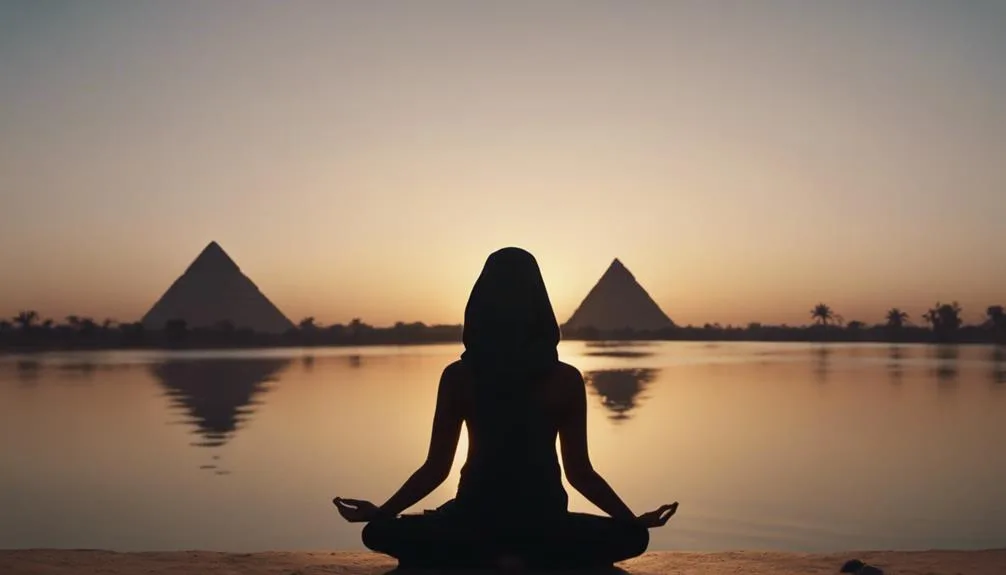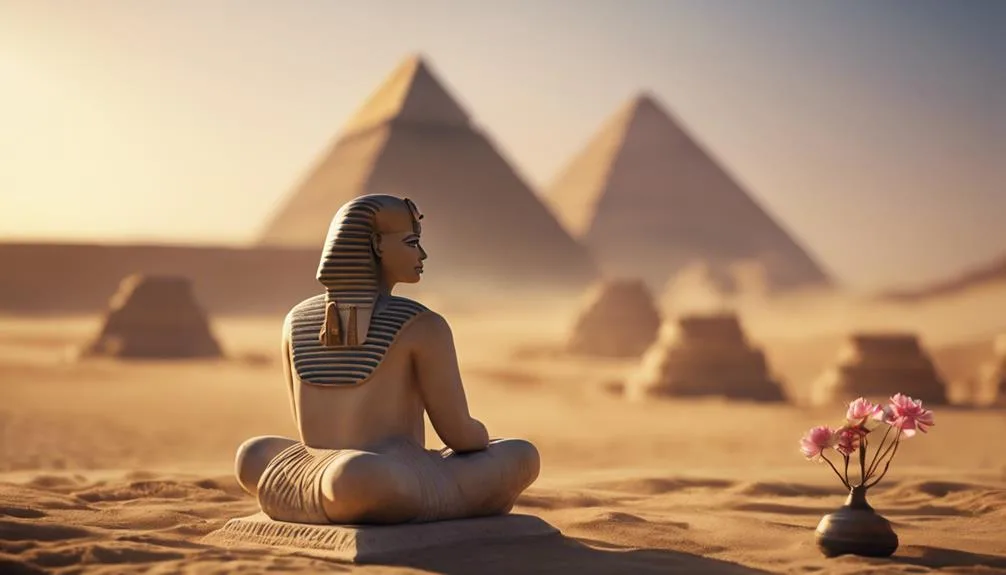The Ancient Egyptian Roots of Meditation: Practices and Philosophies
Before you could say 'Google it,' the Ancient Egyptians were already deep into the art of meditation, weaving it seamlessly into their daily routines and philosophies.
You might find it intriguing how they integrated such practices into their educational systems, aiming for spiritual enlightenment and a closer bond with the Divine.
Their methods, including the lesser-known Kemetic Yoga, laid the groundwork for what you recognize as meditation today.
Yet, the depth of this influence on modern practices is where the true fascination lies. Stick around, and you'll uncover how these ancient techniques continue to shape our quest for mental and soul strength.
Key Takeaways
- Ancient Egyptian meditation integrated visualization, breath control, and rituals for mind-body-spirit harmony.
- Philosophies emphasized unity with the cosmos and divine through mind control and self-awareness.
- Practices like Kemetic Yoga show ancient Egyptian meditation's influence on modern holistic wellness.
- The legacy includes mental clarity, spiritual growth, and a global impact on contemporary meditation practices.
Origins of Egyptian Meditation
How did meditation emerge as a fundamental practice within Ancient Egypt's education system, reflecting its pivotal role in the daily and professional lives of its people?
The answer lies deep within the Ancient Egyptian Path, where meditation wasn't merely a practice but a cornerstone of their civilization. This profound integration can be traced back to Ancient Egyptian Hieroglyphic texts, which illuminate the history of meditation practice in a society that valued mental and soul strength as paramount for achieving professional excellence and spiritual development.
Kemetic Yoga, a form birthed from this ancient wisdom, encapsulates the essence of their meditation practices. It wasn't just about achieving physical flexibility but about engaging in energy-centric postures designed to harmonize the body, mind, and spirit. This holistic approach underpinned their belief in the practical application of meditation across various disciplines, from engineering to design.
Masters of Kemetic Yoga, revered for their intellectual prowess, showcased how meditation fostered an unparalleled depth of creativity and problem-solving capabilities. Through this lens, it's evident that the ancient Egyptians didn't just practice meditation; they lived it, allowing it to shape their approach to education, professional life, and the quest for spiritual enlightenment.
Techniques and Rituals
Building on the foundational role of meditation in Ancient Egyptian civilization, it's crucial to explore the specific techniques and rituals that facilitated their profound spiritual journeys. Ancient Egyptian meditation practices were deeply rooted in visualization, breath control, and the recitation of sacred texts. These techniques were not mere exercises but pathways to spiritual enlightenment and inner transformation.
| Technique/Ritual | Purpose | Implementation |
|---|---|---|
| Visualization | To invoke divine energies | Using hieroglyphic texts as guides |
| Breath Control | To achieve inner calm and focus | Integral part of meditation sessions |
| Recitation | To connect with the divine | Chanting of sacred texts |
| Offerings | To honor deities and align with their essence | Part of temple ceremonies |
| Purification Rituals | To cleanse body and spirit | Before engaging in meditation practices |
These methods were meticulously developed by priests and priestesses, who underwent rigorous training. Through offerings, temple ceremonies, and purifications, they established a sacred space for meditation. The depictions of specific postures and gestures in hieroglyphic texts highlight the importance of physical alignment in reaching spiritual enlightenment. The intertwining of meditation with religious beliefs underscored the Egyptians' quest for unity with the divine, emphasizing meditation's crucial role in their spiritual and cosmological understanding.
Philosophical Underpinnings

Delving into the philosophical underpinnings of Ancient Egyptian meditation, it's evident that the practices were grounded in a profound understanding of the self's connection to the cosmos. Central to this philosophy was the concept of the Higher Self, known in Ancient Egyptian as Neter Neteru. This belief underscored the aim of meditation: to transcend ego-consciousness and align oneself with universal truths. Through such practices, the Ancient Egyptians embarked on a journey towards the limitless expansion of the soul, seeing meditation not just as a spiritual exercise but as a crucial component of education and human development.
The integration of meditation into education highlighted its importance in facilitating not only personal transformation but also in fostering a deeper connection with the Divine. Achieving mind control and exploring a deeper existence were seen as essential steps towards unity with the Divine. This unity wasn't conceptualized as mere abstraction but as a tangible experience of oneness, achieved through disciplined practice and profound inner reflection.
In this light, Ancient Egyptian meditation was more than a practice; it was a pathway to understanding and living in harmony with the deeper realities of existence, emphasizing the journey of the soul towards an ever-expanding awareness and unity with the cosmos.
Influence on Modern Practices
Reflecting on the philosophical foundations of Ancient Egyptian meditation, it's clear that its techniques and goals have profoundly influenced modern practices, from visualization to breathwork and the quest for spiritual connection. You'll find that today's meditation and mindfulness practices owe much to the ancients, emphasizing:
- Visualization: Ancient Egyptian meditation utilized vivid imagery to connect with the Divine, a technique that's central to many modern meditation practices.
- Breathwork: The focus on controlled breathing to achieve a meditative state is a direct inheritance from Ancient Egyptian practices.
- Spiritual Connection: Just as the ancients sought unity with the Divine for spiritual enlightenment, contemporary practices echo this quest for a deeper spiritual connection.
- Transcending Ego-Consciousness: Ancient Egyptian meditation aimed at connecting with the Higher Self by overcoming ego-consciousness, a goal mirrored in modern spiritual philosophies.
- Incorporation into Education: The integration of meditation into Ancient Egyptian education has inspired current trends of mindfulness practices in schools, aiming to enhance mental well-being and focus.
These elements demonstrate how Ancient Egyptian meditation hasn't only inspired but also shaped the landscape of modern practices, underscoring the timeless pursuit of spiritual enlightenment and self-awareness.
Legacy and Continuation

Exploring the legacy and continuation of Ancient Egyptian meditation practices reveals that Kemetic Yoga, with its deep roots in the past, remains a vibrant and globally practiced method for achieving spiritual and physical well-being today. This tradition, deeply embedded in the teachings of the ancients, offers a path to mental and soul strength, emphasizing the importance of energy-centric postures for enhancing spiritual growth and balancing chakras.
| Aspect | Influence on Practice | Outcome |
|---|---|---|
| Mental and Soul Strength | Rooted in Ancient Egyptian teachings | Enhanced spiritual growth |
| Energy-Centric Postures | Aim to balance chakras | Connection with divine essence |
| Daily Practice | For personal and professional excellence | Promoted holistic development |
| Holistic Development | Supported by intellectual and spiritual aspects | Encouraged personal excellence |
Kemetic Yoga, as practiced today, is more than just physical postures; it's a comprehensive system that integrates the intellectual and spiritual aspects of the self, mirroring the holistic development revered by the ancients. This practice encourages daily engagement, aiming for a balanced life and the attainment of personal excellence, much like the Ancient Egyptians who seamlessly wove meditation into their daily lives for a fully realized existence.
Frequently Asked Questions
Did Meditation Originate in Egypt?
You're asking if meditation first appeared in Egypt. It's believed so, with practices like Pyramid silence and Nile mindfulness rooted there. Hieroglyphic texts describe Osiris breathing and Sphinx contemplation, emphasizing meditation's profound significance in ancient Egyptian culture.
How Did Ancient Egyptians Practice Spirituality?
You'd find Ancient Egyptians deeply engaged in spirituality through temple rituals, divine communication, and ancestor worship. They revered nature, aligned with cosmic forces, and employed sacred geometry in their mystical practices, seeking unity with the divine.
What Are the Origins of Meditation?
The origins of meditation trace back to mindfulness origins, Zen Buddhism, Indian traditions, Vedic practices, and Taoist influences. Silent retreats, mantra chanting, Sufi whirling, and yogic roots all contribute to spiritual awakening across cultures.
What Is Egyptian Position Meditation?
Ironically, you might think sitting still is easy until you try Egyptian Position Meditation. It's more than just the Lotus position; it involves breathing techniques, mental focus, and physical alignment for spiritual benefits and inner peace.
Conclusion
In conclusion, your journey into the ancient Egyptian roots of meditation reveals a profound legacy, where 95% of modern techniques find their echo in these ancient practices.
As you've discovered, Egyptian meditation wasn't merely a practice but a philosophy intertwined with their daily life and education, emphasizing unity with the Divine.
This historical exploration underscores the timeless relevance of these techniques, encouraging a deeper appreciation and integration of their wisdom into today's meditation practices, enriching our spiritual and mental wellbeing.






